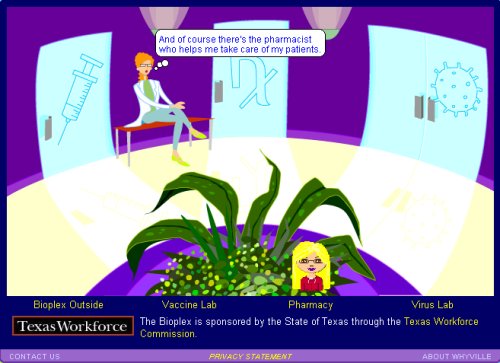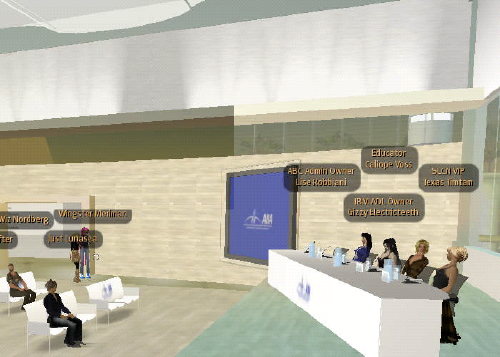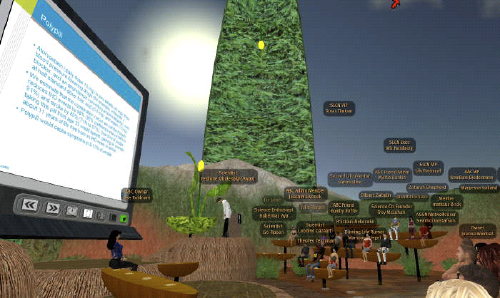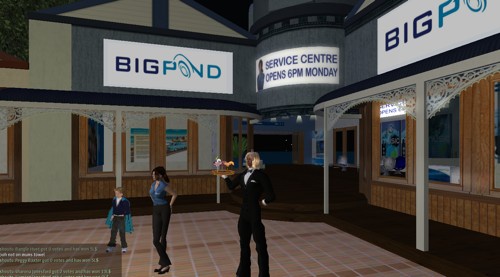1. Starshine & Kelvinblue on slcn.tv
2. Second Life on Max settings
3. A Hobo Second Life…
Tech -- Culture -- Humour
1. Starshine & Kelvinblue on slcn.tv
2. Second Life on Max settings
3. A Hobo Second Life…
In what’s likely to be a pretty popular move, Linden Lab have formalised their stance further on ‘ad farms’ by essentially banning them on Mainland sims – unless an advertising license is sought.
The deadline for removal of ad farms is October 1 – I can already hear the cheers from mainland SL residents. What are your thoughts – is this an outright godsend or are there downsides?

When it comes to the use of virtual environments, the healthcare industry is no less prone to fall into marketing pits of doom than any other industry. Static data, presented in a slap-dash fashion like posters on a wall. Huge, unused buildings that serve no particular purpose, and the occasional video. This seems to be the standard fare presented by companies and organisations coming into virtual environments who are not sensible about use of the medium. Often, these folk would have been better served by a well-organised Web page than the mish-mash they present within virtual environments. Indeed, their attempts are distinctly reminiscent of the early days of the Web, before people got a handle on that medium.
It’s not all bad, however. A couple of companies and organisations have produced useful and significant services that are appropriate for virtual environments. They have clearly thought about how best to discharge the services they already provide to demographics containing the folks they previously had a great deal of trouble reaching. People who use virtual environments, and who:
a) are unable or unwilling to leave their homes to obtain health information or care;
b) suffer from chronic illnesses that require some maintenance by the patient that can be bolstered by health information or care delivered online;
c) are young, not requiring specific healthcare, but can benefit from information delivery.
One of the best efforts open to the public eye is Palomar West hospital, a venture by Cisco, Palomar Pomerado Health, and metaverse developers Millions-of-us. The Second Life version of the hospital, built before the real version, is an exact model of what you can expect to see in San Diego in 2011, to the extent that several rooms are fully kitted-out with the sort of equipment that will fill the real thing. The Second Life exhibit is quite interactive, and provides an excellent idea of how things might operate in reality. Cisco Systems will power the real hospital. A central, internal network will be created to support the operation of the hospital, from patient locations via RFID tags, to room temperature and lighting via bedside screens, to the robotic technology that enables surgeons to operate remotely and automated systems for diagnostic work. Incidently, when we wandered past the site to take a closer look, a research study was being conducted. It’s good to know that this virtual environment replica is useful not only for future patients, and public healthcare at that level of education, but also for medical and other professionals.
Another ongoing project that has proved to be successful is one put on by the CDC in Whyville. Whyville is a virtual scientific learning environment for kids aged 8 to 15 years old. During the influenza season in the real world, Whyvillians are also placed at risk of developing the “Why-flu”, which causes sneezing and red spots on the avatar’s face. Not only were kids given the chance to have their avatar inoculated prior to the Why-flu season beginning, during the season those who caught the flu had a chance to buy remedies from the pharmacy, which were time-limited, and which came at a cost. During the second round of the project in 2007-2008, Whyvillians were encouraged to invite their grandparents to come and be virtually inoculated also. Thus information was disseminated across several generations online, and no doubt further than that offline, to other family members, and from there into the wider population.
This year the CDC has teamed up with CIGNA to produce a healthcare island in Second Life.
“About 90% of what we’re doing with chronic disease management involves behavior change. We could do more for our patients who have diabetes, weight problems or hypertension by helping them relieve their stress and achieve better mental health.” This is what they hope to cover in the virtual environment.
We are yet to experience the island for ourselves, however given the success of the Whyville project, it seems that the CDC have an excellent idea of what it takes to sell healthcare information to the younger generation; it will be interesting to see what tack they take for older folk. Most people like to take their medicinal information with a spoonful of sugar – experience will tell whether games will be the sweetener required, or whether talks and general social interaction are the preferential nectar.
Another site of note: the Second Health hospital or Polyclinic, Second Health London in Second Life. In a similar fashion to the West Palomar site (though in less detail), the Polyclinic displays a 3D representation as it might exist in real life. The establishment can be toured, though perhaps the machinima made at the site in Second Life, with accompanying information, is more enlightening. Though an entire medical campus has been built, with signs denoting the areas in which GPs and specialists will see patients, the acute care clinic and diagnostic facilities, none of the detail of equipment or functioning of the clinic has been created.
Yet another fantastic use of virtual environments is exemplified by the folk over at Play2Train. A town and two hospitals have been fitted out to enable “Strategic National Stockpile (SNS), Simple Triage Rapid Transportation (START), Risk Communication and Incident Command System (ICS) Training”.”Play2Train provides opportunities for training through interactive role playing.”
For a quick round up of other nifty virtual doings in healthcare, visit this link.
There is a vast diversity of healthcare information that needs to be delivered, both to professionals and to the general public. Virtual environments may only slowly be coming into their own in this realm, however, there is hope for them yet.
It’s been a big week for Linden Lab. They’ve recorded their highest ever level of concurrent users (more than 68 thousand online at one time) – positive growth albeit with some intermittent login issues at the same time. We’re looking forward to the next lot of metrics from Linden Lab to see what impact the growth has had on active Australian resident numbers.
In the past 24 hours another significant event occurred with the launch of the SLim client – basically it’s an instant messaging application that allows you to see which SL friends are online. Tateru Nino gives an excellent overview of SLim on Massively and it’s fair to say she wasn’t impressed. As of a few hours ago, you can no longer download SLim. Apparently the link for downloading wasn’t meant to be public. It’s an unfortunate saga in the context of increased growth of residents and the support for applications that allow greater interaction without firing up the full browser. Here’s hoping an improved version appears soon.
VastPark have been a littler quiet on the news front recently but they’ve changed that today with the announcement of a virtual worlds’ player called Immersion. The player, which will be open source, will allow for VastPark-created worlds to be embedded into websites. VastPark themselves mention Google Lively as the obvious comparison.
CEO Bruce Joy’s take:
“We think that virtual worlds will start to become more utilitarian: you can create a room in minutes and decide to have a VoIP based meeting in there. This will lead to many businesses wanting to host their own micro worlds just as they host their website. We want to make that easy, low cost and provide an open source and a commercial white label software choice.”
Immersion will have scriptable “PowerPoint-style” controls and the current Browser and Viewer technology used in VastPark will be merged into Immersion.
The open-sourcing of Immersion comes on top of the VastPark server code being open source, so it’s an overt strategy by VastPark. It’s probably a necessary strategy as well given that behemoths like Google Lively are now competitors. That said, the open source route is being pursued with some protections built in for the company. Lead Developer at VastPark, Craig Presti, explains:
“VastPark is built for developers, by developers. The whole system is easily extended by developers creating plugins that can remain proprietary or be open sourced at the discretion of the developer. We’ll continue to release binaries under an entrepreneur friendly end user license. That’s much better than being essentially forced to open source your widget or your plug-in by the GNU GPL. We think there’s a middle way.”
Whether this middle way is the path to success is obviously up for grabs. What’s encouraging is that a smaller (and partially Australian-based) player is remaining in the game and not being fazed by the ever-growing competiition in the marketplace.
We’re waiting on confirmation from vastPark on Immersion’s release date.
A year ago we covered the AIIA inworld-forum titled “Are Virtual Worlds relevant to my Marketing Effort?”

The same week, ABC Island ran a CSIRO forum on human life extension.


PacRimX (Pacific Rim Exchange)
Stan Trevena, director of technology for Modesto City Schools, is the man responsible for the PacRimX project, developed in 2007. The idea was that kids from Modesto and their counterparts from Kyoto Gakuen in Japan would be able to interact with each other in a virtual environment, prior to an international student exchange in which 20 Modesto students traveled to Japan, and vice versa with 50 Japanese students.
Due to time-zone issues, video-conferencing was ruled out as a solution early on. Instead, Trevena bought an private Island on the Teen Second Life Grid. He fitted it with some basics, including a welcome centre, but noted that “a lot of the innovative use of the island will come from the kids.” The number of islands has now expanded to four. Trevena describes the facility as “a place for our students to communicate and collaborate with each other in building a place where they can share their interests, cultures and languages.”
Students from Kyoto arrived in Modesto on June 24, 2008.
Westley Field, Director of Online Learning at MLC School Sydney, founded the Skoolaborate Project in 2007. Skoolaborate works with junior high schools around the globe to foster students collaboration, involving the use of digital technologies: wikis, blogs, virtual environments and other online learning tools. The Skoolaborate learning space, also on the Teen Second Life Grid, is a private, secure area with an invitation required to access it. “Skoolaborate now has 14 schools from Australia, New Zealand, Taiwan, Japan, Singapore and the USA.”
“In the Global Challenge, teams of US high school students collaborate with international counterparts from October to May to address global climate change and compete for prizes and scholarship awards.”
Approximately 2,000 students have already participated in their program.
Kyoto Gakuen has been working with both Skoolaborate and PacRimX independently since the genesis of each program in 2007. This is how a relationship developed between the directors of the programs, which ultimately led to the merger between the two. The Global Challenge program was brought in separately, to complement the work of the others.
The resulting merged program, featuring input and participation by 17 schools from across the globe, is now the world’s largest virtual environment project, designed for kids of junior high school age.
“Schools collaborate using a variety of online tools and environments to share experiences, thoughts and ideas from around global understanding, social and environmental education.”
Thoughts
Having a private project on the Teen Second Life Grid could have been a great way to ensure that students encountered a slow-moving, sterile environment, with great homogeneity of culture, opinion and thought. However, this partnership should bring together a rich and diverse mix of folks, students and educators, which should create a varied, stimulating environment in which to learn.
Linden Lab is in flux, and the cause is not at all clear: speculation is rife and rumors abound, and the Lab has all but cut off communications with it’s residents. The Millennial Generation does not seem to be the target audience for the Second Life “platform” – this indicates that there is unlikely to be an “Education Grid” any time soon, or perhaps at all. It looks like the program developed by the combined force of PacRimX, Skoolaborate and Global Challenge will be the one of the largest contenders for an alternative.
The question is: will the Teen Second Life Grid remain active for long enough for any of their goals to come to fruition?
Telstra today took the next step in the ongoing evolution of their significant presence in Second Life with the launch of a staffed customer service centre. There’ll be Telstra-employed avatars available between 11am and 10pm Monday to Friday AEST to answer “service-related queries”. Obviously there won’t be too many queries from those whose connection has gone down but it’s a worthy expansion of customer service in-world.
A launch party was held from 5pm today:

There’s plenty of space to wait if it comes to that:

With sixteen sims, Telstra are a corporate behemoth in Second Life and a successful one at that. It’ll be interesting to see how many people utilise the service. The press release states that “this initiative was driven by the popularity of this virtual world with BigPond customers”. We’ve asked for some figures on this – the common assumption behind Telstra’s popularity is that BigPond customers have their Second Life usage unmetered and it’d be good to get some solid figures behind the claim.
The natural reaction from non-Second Life residents would be to ask why you’d bother logging in to ask a question when it’s easier to phone or email the query. To some extent this is valid but it misses the point of the exercise (beyond its PR value) – it’s one of the few corporate experiments in actual virtual world customer service. Whether it’s successful is only part of the equation – it’s useful research for the future when virtual worlds more successfully enable business transactions. This sort of exercise is fodder for that future.
Copyright © 2024 · Magazine Child Theme on Genesis Framework · WordPress · Log in
Recent Comments